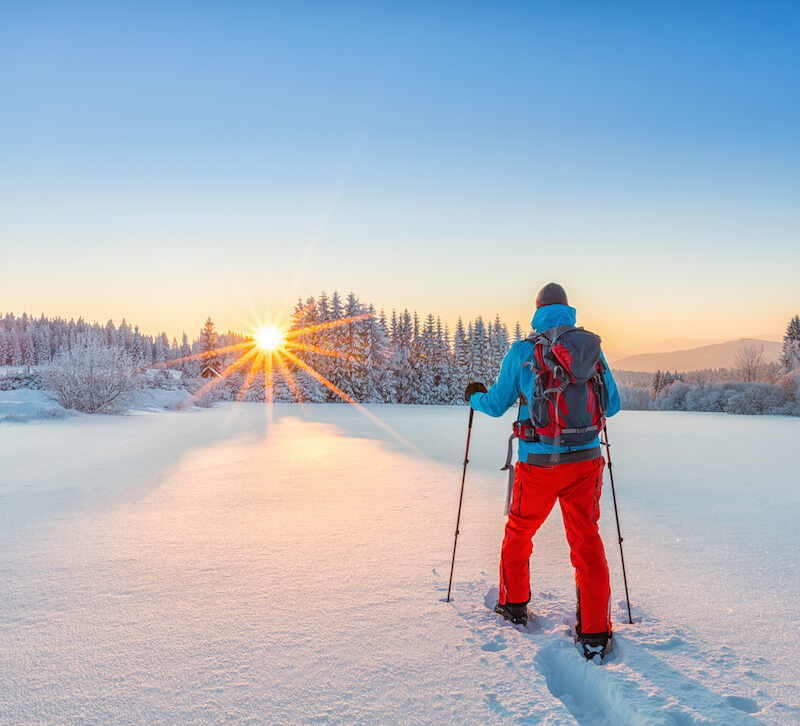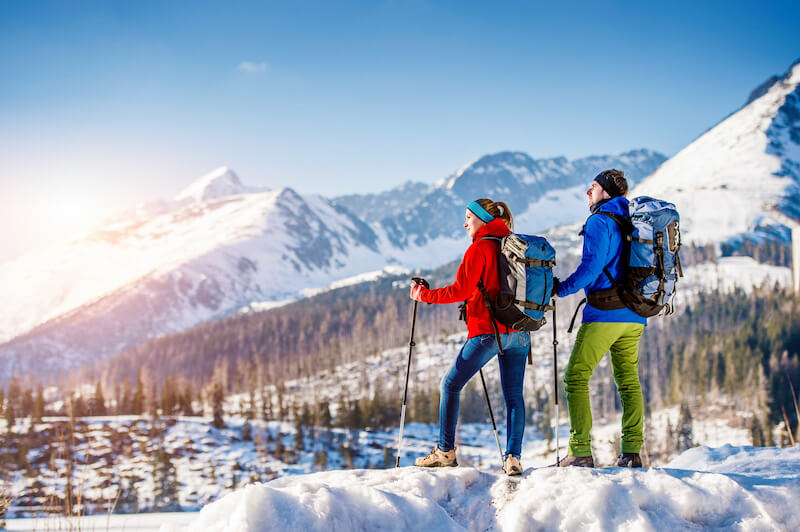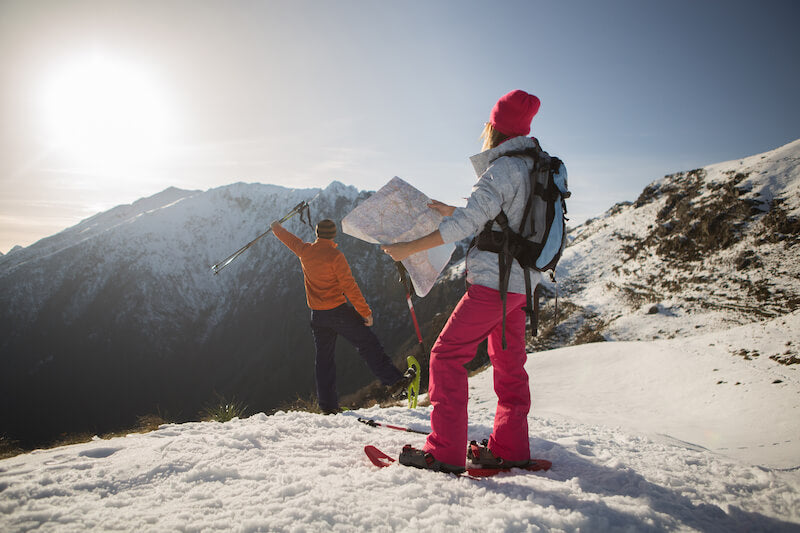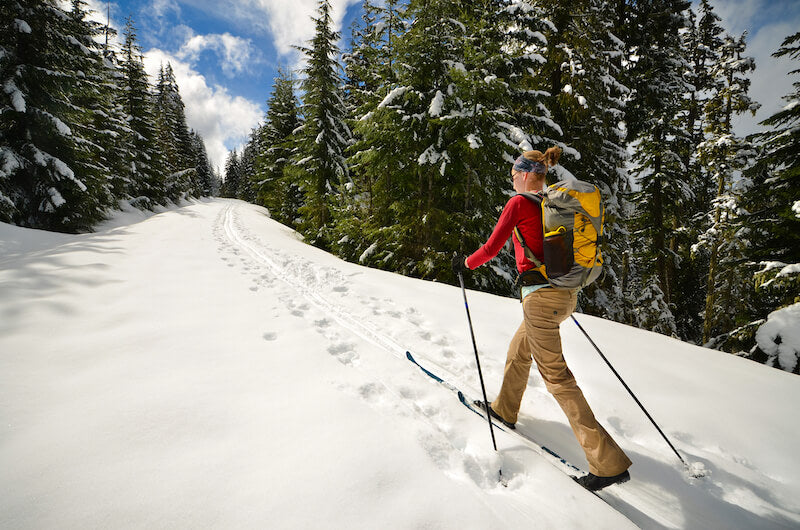Your Cart is Empty
Winter’s right around the corner. The days are getting colder and shorter. Wildflower meadows are a distant memory. Dusty trails are covered in ice and snow.
It’s tempting to grab your softest throw and settle into your couch for a long winter of drinking your weight in hot chocolate and becoming the first person to watch every. Single. Thing. On. Netflix. Staying active outside when it’s freezing cold may seem like something only Scandinavians or truly crazy people do. But the truth is, you can enjoy outdoor activities in cold weather!
Hear me out— even if you hate being cold, it’s possible to have a blast outdoors in winter! You just have to plan a little more to stay warm and safe. Not only that, but your health will benefit too! People who spend 120 minutes or more a week in nature report fewer health problems. And who doesn’t want that?!
And if you get outside the right way, it’s awesome. The hush of a forest blanketed by snow, mountains illuminated in the soft winter light, a break from technology, quality time with friends and family. Plus— after a long day trekking in the woods, you’ll have deserved that Netflix marathon.
With a little preparation, it is possible to get your nature fix all year round. Read on for the ultimate guide to cold weather activities.
One of the best ways to truly enjoy being outdoors in winter is to do something that you can’t do any other season. You’ll come to appreciate winter for its unique offerings, rather than just viewing it as “several months of freezing cold torture.”
Try these activities that you can only do in the winter.

Snowshoeing. Snowshoeing is an ideal outdoor cold weather activity for families or spending social time with friends because it doesn’t require a lot of technical skill. If you can walk, you can snowshoe.
And if you can walk in clown shoes, you’re gonna be a snowshoe rock star.
A few things to keep in mind:
Cross-country skiing. Life in the (slightly faster) lane. Cross-country skiing offers the same benefits as snowshoeing (miles of quiet trails, outdoor exercise, spending time in nature) but requires more equipment and skill. It’s still a great way to spend time outdoors with family and friends, once you get the hang of it.
Here’s an excellent beginner’s guide to cross-country skiing.
Downhill Skiing. If you’re looking for more of a thrill, try downhill skiing or snowboarding. Ski resorts have runs designed just for beginners.
Winter Camping. That’s right— winter camping. One of the most surefire ways to truly be alone in nature, winter camping can be just as awesome as summer camping, with the right gear. Imagine waking up to the quiet hush of freshly fallen snow, the sun illuminating peaks in the distance, and being the only soul around for miles. Winter camping is amazing, but it’s serious business. I only recommend it if you have advanced outdoor skills.
Tips for Success.

Yes, you’ll be headed to the great outdoors where the wind howls and temperatures drop to the single digits, but adventuring in the cold and snow is hard work! Think in layers— three, to be exact— to avoid overheating and to stay comfortable when you’re exercising in cold weather.
The best base layers are lightweight and made from synthetic or wool fabrics, like our upcycled polyester leggings. Never wear cotton when out in the cold. The job of your baselayer is to keep you warm and dry, and cotton hangs onto moisture (aka sweat), which is dangerous when you’re active in cold weather.
This is your insulating layer. Again, avoid cotton and stick with synthetics or wool. Good options are puffy fleece pullovers, synthetic or natural down jackets. Be aware that some materials, like fleece, are not wind resistant, so you’ll want to make sure your third layer makes up for that.
Here’s the deal— no rain gear is 100% waterproof. None. Outdoor gear manufacturers have to balance breathability with performance. It’s best to go into your winter adventures knowing that up front. Now you can manage your expectations about how a rain jacket or pants will perform.
That said, I spend my outdoor adventures in the rain-soaked Pacific Northwest and have had no serious issues with my rain gear. Especially if I get my first two layers right.
Generally with rain wear, you get what you pay for. Look for the option that best suits your climate, at a price you can pay.
Once you’ve nailed down your layers, it’s time to throw in gloves, hats, scarves, socks, and boots. This is mostly down to personal preference. If you lose heat like crazy, you’ll want to make sure you have all of the above and then some. You can always shed them if you start warming up.
Many outdoor adventurers, myself included, barrel right through the cold weather months with a pair of trail runners. If you want more stability and warmth, go with hiking boots with great traction.
Oh— and don’t forget to grab a mask!
This one can’t be stressed enough. While getting outside in winter carries enormous health and physical benefits, it only does so if you get home safely!
The 10 Essentials list was developed in the 1930s by The Mountaineers, an outdoor organization based in Seattle, Washington. It includes all the items necessary to safely enjoy your cold weather adventures. Take this list seriously!
If you do any summer hiking or outdoor adventuring, you know this list! But there are a few extra things to consider for winter safety.

Grab a backpack and fill it with:
1. Navigation tools. While smartphones and GPS have a place in outdoor activities, for safety and accuracy, it’s always best to carry a paper map and compass. Keep your map in a waterproof bag, and know how to use your compass.
2. Headlamp (and batteries). Winter days are short, and if you’re out around sunrise or sunset, you want to make sure you can safely find your way back to the trailhead. A headlamp will help you do that.
3. Sun protection. Yep, even in winter you’ll need sunscreen, sunglasses, and sun-protective clothes.
4. First aid. Carry a small kit with the basics— antibacterial gel, bandages, pain medication, and wraps for minor injuries.
5. Knife or multitool. Helpful if you need to make gear repairs, gather emergency kindling, or prep food.
6. Fire starter. Carry matches, tinder, a lighter, and/or a stove, and know the basics of fire safety and etiquette in the woods.
7. Shelter. A space blanket is the usual choice for emergency shelters and will do a surprisingly good job of keeping you protected from the cold weather.
8. Extra food. Exercising in cold weather is hard work! Bring what you think you’ll need, plus a little extra. Some good options are energy bars, jerky, fresh fruit, dried fruit, and nut butters. If it’s cold enough, your food can freeze. So keep it in an insulated bag in your backpack.
9. Extra water. Your summer hydration bag isn’t the best option in winter. The tubing is exposed to the cold and can freeze, leaving you without water. Go with an insulated water bottle or thermos and keep it inside your backpack. Pro-tip— for extra winter fun, bring a thermos of hot cider or hot chocolate!
10. Extra clothes. We covered the basics above, but it’s always a good idea to carry extra socks, base layers, or anything else you think you might need for backup. If your digits are really prone to the cold, consider bringing heated gloves or hand warmer inserts.
11. Bonus essentials. Carry a trash bag for your own waste and any waste you (unfortunately) find along your route. A small shovel is a good idea in winter— just in case you need to shovel snow.
A vital part of enjoying the outdoors in winter is having a solid safety plan. Trust me— the last thing you want is for your winter wonderland trip to end up with you stranded on a ridge during a snowstorm with zero visibility and sundown coming fast.
Follow our winter preparedness plan to get you safely outdoors in cold weather.
It’s a good idea anytime you get out in the wilderness to have a solid plan. Write it down and share it with at least one person who’s not going with you.
You’ll want to note:
Checking the weather will help you avoid any surprises. If you’ve got your sights set on a ridge trail, but there’s a blizzard coming and avalanche danger is high, then you’re going to want to pick another outdoor adventure. And if you want to go snowshoeing only to get to the sno-park and there’s no snow, you’re not going to be a very happy camper— er, snowshoer!
Check state and local weather conditions, as well as traffic cams on the roads you’ll be traveling. Oh— and don’t forget chains or traction tires! They’re required on mountain passes.
Call ranger stations in your area to ask about snow depth, or join outdoor groups on Facebook to read recent trip reports. You can also look at snow levels on the NOAA website here.
Conditions can change quickly, so make sure you’re prepared by checking the weather in advance.

Tree Tribe is an outdoor lifestyle brand. We’re committed to creating products that align with our sustainable values, and to planting trees on every sale.
We want to spread good vibes and a love for nature, and that includes protecting and caring for our natural spaces!
The Leave No Trace principles are just as important with cold weather activities as they are in summer. In a nutshell, Leave No Trace simply means leave nature as good as or better than you found it. Pack your trash out and be awesome to nature and wildlife.
We hope this guide helps to inspire you to get outside, no matter the weather!
For more outdoor lifestyle tips and inspiration, follow us on Instagram.



